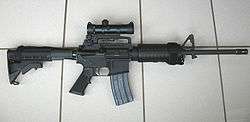Colt AR-15
| Colt AR-15 | |
|---|---|
|
The Colt AR-15 SP-1 | |
| Type | Semi-automatic rifle |
| Place of origin | United States |
| Service history | |
| In service | 1958–present |
| Production history | |
| Designer | Eugene Stoner, Jim Sullivan, Bob Fremont |
| Designed | 1957 |
| Manufacturer | Colt |
| Variants | Carbine |
| Specifications | |
| Weight | 2.27 kg–3.9 kg (5.5–8.5 lb) |
| Barrel length |
|
|
| |
| Cartridge | 5.56×45mm NATO, 7.62×39mm, 9mm Parabellum |
| Action | Direct impingement |
| Effective firing range | ~550 metres (600 yd) |
| Feed system | Detachable magazine |
| Sights | Adjustable front and rear iron sights |
The Colt AR-15 is a lightweight, 5.56×45mm, magazine-fed, air-cooled semi-automatic rifle with a rotating bolt and a direct impingement gas-operation system. It was designed to be manufactured with the extensive use of aluminium alloys and synthetic materials. Introduced in 1964, Colt has made many different types of AR-15 rifle and carbine models: including the AR-15, AR-15A2, AR-15A3, Sporter, HBAR, Government, Target, Match and many other models.
It is based on the ArmaLite AR-15 rifle, a select-fire weapon intended for military sales. In 1959, ArmaLite sold the design to Colt due to financial difficulties. After some modifications, the rifle eventually became the United States military M16 rifle. Shortly thereafter, Colt began to make semi-automatic versions for civilian sales. The term "AR-15" is a Colt registered trademark, which they use to denote only the semi-automatic rifle versions available for civilian and law enforcement sales.
The term "AR-15" signifies "Armalite rifle, design 15".[1] Other manufacturers make AR-15 clones and variants marketed under separate designations, although these are frequently referred to as AR-15s. This article discusses the semiautomatic version manufactured by Colt.
History
The Colt AR-15 is based on the 5.56 mm ArmaLite AR-15 rifle, which is a smaller lighter version of the 7.62 mm ArmaLite AR-10. Both of these rifles were designed by Eugene Stoner, Robert Fremont and L. James Sullivan of the Fairchild Armalite corporation.[2] The "AR" in all ArmaLite pattern firearms simply stands for "ArmaLite Rifle"[3] and can be found on most of the company's firearms: AR-5, a .22 caliber rifle; the AR-7, another .22 caliber; the AR-17 shotgun; the AR-10 rifle; and the AR-24 pistol.[4]

In 1959, ArmaLite sold its rights to the AR-10 and AR-15 to Colt. After a Far East tour, Colt made its first sale of Colt made ArmaLite AR-15 rifles to Malaya on September 30, 1959. Colt manufactured their first batch of 300 select-fire Colt ArmaLite AR-15 Model 01 rifles in December 1959.[5] Colt marketed the Colt made ArmaLite AR-15 rifle to various military services around the world. After modifications (most notably the relocation of the charging handle from under the carrying handle to the rear of the receiver), the new redesigned rifle was adopted by the United States military as the M16 rifle. Most Colt ArmaLite AR-15 rifles in U.S. service have long ago been upgraded to M16 rifle configuration.
In 1964, Colt started selling the semi-automatic version of the M16 rifle as the Colt AR-15 for civilian use and the term has been used to refer to semiautomatic-only versions of the rifle since then. Colt continued to use the AR-15 trademark for its semi-automatic variants (AR-15, AR-15A2) that were marketed to civilian and law-enforcement customers. The original AR-15 was a very lightweight weapon, weighing less than 6 pounds with empty magazine. Later heavy-barrel versions of the civilian AR-15 can weigh upwards of 8.5 lb.
Operating mechanism

U.S. Patent 2,951,424 describes the cycling mechanism used in the original AR-15. The bolt carrier acts as a movable cylinder and the bolt itself acts as a stationary piston. This mechanism is often called "direct gas impingement" (DGI), although it differs from prior gas systems.

Gas is tapped from the barrel as the bullet moves past a gas port located above the rifle's front sight base. The gas expands into the port and down a gas tube, located above the barrel that runs from the front sight base into the AR-15's upper receiver. Here, the gas tube protrudes into a "gas key" (bolt carrier key), which accepts the gas and funnels it into the bolt carrier.
At this point, the bolt is locked into the barrel extension by locking lugs, so the expanding gas forces the bolt carrier backward a short distance. As the bolt carrier moves toward the butt of the gun, the bolt cam pin, riding in a slot on the bolt carrier, forces the bolt to rotate and thus unlocks it from the barrel extension. Once the bolt is fully unlocked it begins its rearward movement along with the bolt carrier. The bolt's rearward motion extracts the empty cartridge case from the chamber. As soon as the neck of the case clears the barrel extension, the bolt's spring-loaded ejector forces it out the ejection port in the side of the upper receiver.
Behind the bolt carrier is a plastic or metal buffer, which rests in line with a return spring. The buffer spring begins to push the bolt carrier and bolt back toward the chamber once it is compressed sufficiently. A groove machined into the upper receiver guides the bolt cam pin and prevents it and the bolt from rotating into a closed position. The bolt's locking lugs push a fresh round from the magazine as the bolt moves forward. The round is guided by feed ramps into the chamber. As the bolt's locking lugs move past the barrel extension, the cam pin twists into a pocket milled into the upper receiver. This twisting action follows the groove cut into the carrier and forces the bolt to twist and "lock" into the barrel extension.
Features
Upper receivers

The early commercial SP-1 AR-15s used a pair of .250" diameter receiver push pins, identical to those found on the military rifles. In 1966 the company replaced the front pin with a paired nut and screw hinge using a .315" diameter pin to prevent shooters from being able to change receivers with military rifles or competitor rifles without the use of an adapter. They resumed production with the smaller and standardized .250" pin in the mid-1990s.[6]
Rifling
Early models had a 1:14 rate of twist for the original 55 grain (3.6 g) bullets. This was changed to 1:12 when it was found that in cold weather 1:14 was insufficient to stabilize the bullet. Most recent models have a 1:9 or 1:7 twist rate. The degree to which differing twist rates affect ballistics and terminal performance given varying loads is controversial, although heavier, longer projectiles tend to perform better with faster rifling rates.
Feed systems

The Colt AR-15 uses a detachable box magazine. Standard issue STANAG magazines are 20- or 30-round staggered-column boxes. Low-capacity magazines, usually of a 5- or 10-round capacity, are available to comply with some areas' legal restrictions, for hunting and for benchrest shooting, where a larger magazine can be inconvenient.
Muzzle devices
Colt AR-15 rifles most often have a barrel threaded in 1⁄2"-28 threads to incorporate the use of a muzzle device such as a flash suppressor, sound suppressor or muzzle brake. The initial design, the "duckbill," had three tines or prongs and was prone to breakage and getting entangled in vegetation. The design was later changed to close the end to avoid this problem. Eventually, on the A2 version of the rifle, the bottom port was closed to reduce muzzle climb and prevent dust from rising when the rifle was fired in the prone position.[7] For these reasons, the US military declared this muzzle device a compensator, but it is more commonly known as the "GI", "A2", or "Birdcage" muzzle device.[8] The standard AR15 muzzle device conforms to the STANAG dimensional requirements for firing 22mm rifle grenades.
Variants
See also
- Assault weapon
- Bushmaster XM-15
- Colt Canada C7 rifle
- Fairchild Aircraft
- M4 carbine
- SR-47
- Table of handgun and rifle cartridges
References
- ↑ Armalite - About US. Armalite.com. Retrieved June 18, 2016.
- ↑ "A Historical Review of Armalite" (PDF). ArmaLite, Inc. April 23, 1999. Archived from the original (PDF) on October 1, 2008. Retrieved July 16, 2008.
- ↑ "1952-1954 - Armalite".
- ↑ Shideler, edited by Dan (2010). The official Gun Digest book of guns & prices 2010 rifles, pistons & shotguns. Iola, Wis.: Krause. ISBN 1440214549.
- ↑ Dockery, Kevin (2007). Future Weapons. Penguin. p. 56. ISBN 9780425217504.
- ↑ Sweeney, Patrick (1 October 1999). Gunsmithing - Rifles. Iola, Wisconsin: Gun Digest Books. p. 290. ISBN 0-87341-665-1.
- ↑ Wieland, Terry (November 22, 2011). Gun Digest Book of Classic American Combat Rifles. Iola, Wisconsin: Krause Publications. p. 100. ISBN 978-1-4402-3017-2.
- ↑ Steve Crawford (2003). Twenty First Century Small Arms: The World's Great Infantry Weapons. Zenith Imprint. pp. 85–86. ISBN 978-0-7603-1503-3. Retrieved May 28, 2013.
Bibliography
- Stevens, R. Blake and Edward C. Ezell. The Black Rifle M16 Retrospective. Enhanced second printing. Cobourg, Ontario, Canada: Collector Grade Publications Incorporated, 1994. ISBN 0-88935-115-5.
- Bartocci, Christopher R. Black Rifle II The M16 Into the 21st Century. Cobourg, Ontario, Canada: Collector Grade Publications Incorporated, 2004. ISBN 0-88935-348-4.
| Wikimedia Commons has media related to AR-15. |

